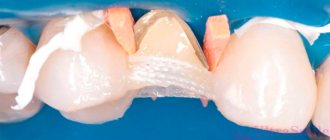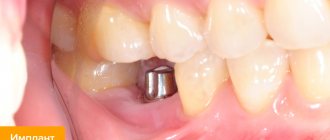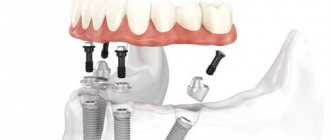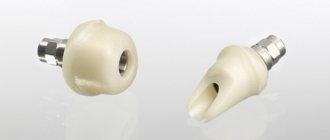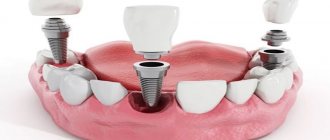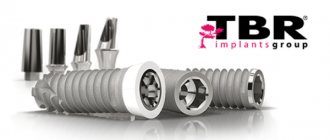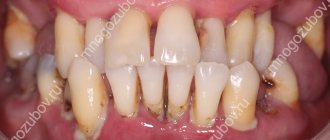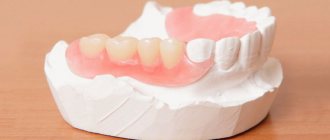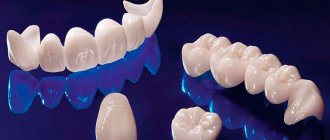Before going to the dentist, many people already decide on the choice of dental prosthetics method. However, without having an idea of the rules for installing a dental bridge and implant, it is impossible to make a decision about what to install.
The article reveals the basic principles of dental prosthetics, indicating the advantages and disadvantages of each method.
What is an implant and a bridge?
Implant design
An implant is, in fact, an artificial tooth, which is a base (pin and abutment) that replaces the root and crown, imitating the natural tooth surface.
The rod, which is implanted into the jaw, is made of high-quality titanium alloy.
Cleaning the metal of impurities reduces to almost zero the body’s negative reaction aimed at rejecting the foreign body.
Bridges are frame prostheses that are fixed to adjacent teeth (supports) with special locks.
The supporting elements are first ground, after which the locking fragments are attached to them.
The second part of the castle is installed on the bridges. This type of prosthetics is performed when one or more teeth are missing in a row.
However, there are restrictions regarding the spacing between supports. If a dentist proposes replacing a large number of teeth with a bridge, this should alert you.
With this approach, overload occurs, both on the supports and on the jaw as a whole. This approach is fraught with the formation of additional dental problems and rapid wear of the prosthesis.
The main differences between bridges and implants are the types of structures and the principles of their fixation. The bridge prosthesis is attached between two supporting elements, which can represent either healthy teeth or implanted metal parts that replace the root.
The implant, or rather part of its structure - the abutment, is installed in the bone tissue of the jaw. A crown, made in advance according to individual parameters, is already placed on the metal base.
By the way, patients who have increased sensitivity to metal do not need to worry about the pin; thanks to modern technologies, implant bases are also made from hypoallergenic materials - fiberglass, carbon fiber.
Dental bridge
Implant installation
What is better - dental implantation or bridge?
For a clear example of the strengths and weaknesses of both options, we provide a comparative table.
| Bridge | Implant | |
| Number of missing teeth | 1-4 | any quantity |
| Degree of mastication recovery | average | full identity to a natural tooth root |
| Aesthetics | average | high |
| Recovery time | up to 1 month | 4-6 months, with bone grafting - up to 1 year |
| Difficulty of installation | average | complex |
| Impact on adjacent teeth | subject to depulping and turning | are not used |
| Jaw bone loss | intense | absent |
| Reliability of fixation | mobility of supports is possible in case of diseases and inflammation of periodontal tissues | complete immobility |
| Difficulty of care | Difficulties arise when food gets under the prosthesis | does not require special care |
| Restrictions on food intake | increased load excluded | any load is allowed |
| Comfort while wearing | There is discomfort in the first days after installation | complete comfort |
| Life time | up to 7 years, depending on the condition of the support units | implant - for life, prosthesis - 15 years or more |
| Price | Average | High |
Our dentists recommend that patients do not delay the restoration of missing teeth. Without load, the jawbone begins to atrophy. The method of filling a gap in the dentition must be decided quickly. Each patient, taking into account his financial capabilities, makes his own decision - whether it will be a bridge or an implant.
Which is better to choose?
Foreign dental clinics consider the installation of implants a higher priority procedure when eliminating dental problems.
This is not at all a tribute to fashion and new technologies; the justification lies in the following important factors:
- Foreign dental clinics consider the installation of implants a higher priority procedure when eliminating dental problems
For the method of prosthetics with implants, neighboring teeth are not involved in the process , unlike the installation of a bridge, when the supporting elements are being prepared. Preparatory manipulations include grinding and depulping the teeth on which the structure is fixed. For healthy teeth, such treatment is traumatic, but they could maintain the integrity of the protective layer for many years.
- When a bridge is placed, it is not always possible to achieve a seal between the prosthesis and the soft tissues. Food debris gradually gets into small cracks and accumulates, which creates a favorable environment for bacteria to multiply. And it is not always possible to detect the early development of disease in supporting teeth; this complicates monitoring the condition of teeth hidden by the structure. There is no such problem with implants.
- Wearing a bridge provokes resorption (absorption) of bone tissue in the jaw at the site of the extracted tooth. Many people underestimate this process, because the consequences are not detected immediately, and external signs become visible after several years. However, almost everyone knows such unpleasant symptoms as a sagging senile mouth and thinning lips. These are the visual consequences of bone tissue resorption.
The success of prosthetics largely depends on the professionalism of the doctor. After an initial examination, the specialist prescribes a series of studies, the results of which determine the possibility of performing an operation to install a bridge or implant.
Implantation of an abutment into bone tissue is not always possible, so a bridge prosthesis has the right to exist, especially since modern materials and technologies have expanded the range of structures themselves and methods of their fastening.
Reference! Any type of prosthetics is performed only after professional oral hygiene procedures.
Indications for installation of bridges:
- in cases where 1 or more teeth are missing in a row;
- inaccessibility of prosthetic implants;
- the presence of diseases and health conditions in which abutment implantation surgery is contraindicated.
Indications for implantation:
- correction of the defect of single inclusion of the dentition;
- installation of 2-3 lost teeth, located in a row or scattered;
- creation of supporting elements for a bridge prosthesis;
- complete absence of teeth;
- individual intolerance to removable bridge prostheses;
- absence of functional occlusion (painful closure/opening of the lower and upper jaws).
Implant installation process and prosthetics
Questions often arise about the choice of type of prosthetics in certain areas of the dentition. In principle, there should be no doubt about implants, because each pin is immersed to the required depth of the bone tissue, and although it remains motionless, there is no additional load on the jaw during chewing.
To restore teeth, combined schemes are often proposed, in which two types of prosthetics are used simultaneously.
In this case, it is proposed to place implants as the front teeth, and bridges as the side teeth. The chewing function of bridges does not pose any danger, and artificial anterior bridges provide more physical comfort and aesthetics.
Dental implantation: should you trust the method?
In order to correctly assess the advantages and disadvantages of dental prosthetics on implants compared to those in the case of using a classic bridge, you must first have a good understanding of how implantation is carried out and what problems it can solve.
First of all, it is worth noting that dental implantation allows you to replace lost tooth tissue in full - not only the crown part, but also the root. In comparison, dental bridges replace only the top of the tooth (crown).
What does this mean in practice? The restored tooth is fully functional - it is not just a crown “hanging in the air” above the gum, but a full-fledged artificial tooth. It can withstand significant chewing (for a posterior tooth) or cutting (for an incisor) load. This load is transferred to the bone through the implant, so the bone tissue does not atrophy, as in the case of a bridge.
Prosthetics on implants can be used in a wide variety of clinical cases, including those where a bridge cannot be installed. For example, in the absence of terminal teeth (the very last in the row) and with complete edentia. For single restorations, one implant is implanted into the bone tissue and a crown is fixed on it. For multiple restorations, several implants are required (for complete edentia - from 4 to 8-10 for the entire jaw), on top of which a prosthesis is attached. See, for example, the article about prosthetic technologies for all teeth in the jaw: All-on-4 and All-on-6.
So, generally speaking, dental implantation is a much more advanced method of prosthetics than using a dental bridge.
This is interesting
In a number of European countries, as well as in the United States, a dentist risks losing his license if he suggests that a patient install a bridge instead of an implant. This also suggests that dental implantation is a safe technique that is trusted by specialists.
Unlike the use of dental bridges, prosthetics on implants has a more impressive list of advantages:
- The average service life of implants is 20 years or more;
- If dentures break, they can easily be replaced with new ones, and the crowns or bridges themselves on implants will last at least 2 times longer than when fixed to living teeth;
- As noted above, the natural anatomical restoration of the tooth is ensured - not only its crown part, but also the root (as a result, the bone is protected from atrophy);
- No grinding of living teeth is required;
- The highest aesthetics are achieved, and much attention is paid not only to the appearance of the crown, but to the gingival margin - the artificial tooth either fits very tightly to the mucous membrane, or a small part of the artificial gum is created in the prosthesis, which allows you to hide the flaws of the natural one (this allows you to abandon gum grafting in the absence of a large number of teeth);
- Wide indications – you can restore either one tooth or an entire row;
- Wide possibilities for prosthetics – implants can support one crown, a dental bridge or a complete denture;
- Absence of allergic reactions – there is no allergy to titanium, which is used in the manufacture of implants.
It is also useful to read: Are dental implants harmful or is it a myth: reviews and contraindications for installation
However, when patients think about which prosthetic option to give preference to - implants or a classic bridge, they first turn not to the advantages, but to the disadvantages of both methods. It is worth noting that dental implantation, if you become more familiar with the technique of its implementation, often frightens and repels people - few people are happy with the prospect of drilling into a bone and screwing a metal “bolt” into it.
But in practice, things are not as scary as they sometimes look in pictures.
Review:
“I’m 26 years old, I had a six removed because the root was cracked. I placed an implant instead of a tooth. So, removing the root was much more painful and painful than installing an implant. But the result is incredibly pleasing, the tooth is like your own!”
Ksenia, Syktyvkar
Here are the key disadvantages of dental implantation:
- A large list of contraindications – installation of implants cannot always be carried out due to the patient’s health condition;
- Sometimes undesirable postoperative consequences are possible, including implant rejection;
- Long treatment – prosthetics can take up to 1 year or more;
- Additional surgical operations may be required - bone augmentation, gum grafting;
- Long preparation for treatment - diagnosis, sanitation of the oral cavity, tooth extraction (if necessary), additional tests may be required to assess the state of health and exclude contraindications to treatment;
- Rehabilitation is required after surgery for implantation (possible swelling, bleeding, pain, suture dehiscence);
- High price. It is the financial side of the issue that scares off many patients.
Review:
“I’m very afraid of dental implants. I have bad heredity - my father has been without teeth since he was 40, and now I myself no longer have three, the rest are not far off either. But I haven’t decided on implantation yet – there are too many negative reviews. I believe that the outcome depends almost 100% on the doctor, and it is very difficult to find a real professional. Once the doctors learn how to diagnose normally, that’s how I’ll decide...”
Irina A., St. Petersburg
See also the article Complications and problems that sometimes arise after dental implantation.
To put it simply, a dental bridge is quick and cheap, while prosthetics on implants is expensive, but it is maximally functional, aesthetically pleasing and durable.
Advantages and disadvantages
Let's look at the advantages and disadvantages of implants and bridges in table form:
| Evaluation of certain types of dental prosthetics | |||
| Implants | Bridges | ||
| Advantages | Flaws | Advantages | Flaws |
| protection against displacement and deformation of adjacent teeth | duration of the prosthetic period | When using modern material, you can achieve an aesthetic result close to natural teeth | When preparing abutment teeth, they are ground down, which damages the protective enamel |
| preventing bone atrophy | high cost of implants and work to install them | fast prosthetics | uneven load on bone tissue, which leads to bone atrophy |
| long period of use without changes in design and bite | presence of contraindications and their strict observance | affordable price | additional load on supporting teeth |
| strength and reliability of the structure | long service life when using implant supports | short service life when ordering budget options (on average 4-6 years) | |
| solves the problem of missing teeth | |||
| makes it possible to install removable dentures | |||
| high aesthetic result | |||
| good percentage of structure survival inside the bone (up to 98%) | |||
Kinds
The history of dental prosthetics has been traced back to the times of the pharaohs. Representatives of the rich classes installed teeth taken from their slaves, using silver and gold for fixation.
Modern dentistry is rapidly developing thanks to the introduction of innovative technologies and materials. This contributes to the expansion of types of prostheses.
Types of implants
Let's take a closer look at the types of implants:
- Root – structurally, the implant exactly imitates a natural tooth. It is divided into varieties according to shape: cylindrical and screw. The first type has a porous structure, due to which the part is retained in the bone tissue and takes root in it. The screw implant is fixed due to the presence of threads.
- Intramucosal - intended for those who wear removable dentures on the upper jaw, which is often associated with atrophy of the alveolar process. One end of the product enters the oral mucosa, the other is fixed to a removable denture.
- Endodontic – is a pin that is screwed inside a natural tooth that has begun to loosen.
- Endosseous - the design is quite miniature and is not super reliable, but in the case of thin bone tissue it is most suitable. The installation process of such a part is labor intensive.
- Subperiosteal is a very complex system, both in manufacturing and installation. A special feature is the absence of the need to drill the bone before fixation.
- Combined - represents a design that combines several other installation principles.
- The mini-implant is part of a removable system. Used as a support, fixing individual elements of the prosthesis.
Types of Dental Implants
Types of dental bridges
The classification of bridge structures is carried out according to several criteria (material, shape of the structure, etc.), but the distinctive feature of the types is the methods of fixation:
- installation on healthy abutment teeth;
- fixation on implants;
- fastening with locks (clasp bridge);
- secured with adhesive materials.
Types of bridges
Promotion! Restorative inlay, veneer, E-max crown
17,000 rub.
Both implant-supported bridges and single crowns:
- suitable for reconstruction of posterior and anterior teeth;
- are made from metal ceramics, ceramic mass, and zirconium dioxide.
Take your time to decide on your own which option to choose. First, visit a specialist who will conduct a diagnostic examination and help you decide whether to install a bridge on implants or perform prosthetics with separate crowns. If the teeth are not removed and there is a chance to save them, you may be offered the option of restoration with zirconium inlays (more details). In any case, the doctor will find the optimal method for restoring teeth in terms of efficiency and material costs.
Possible complications during installation and subsequent problems
After implantation, the same problems that are typical for any surgical intervention may arise. For the most part, complications are explained by poor diagnosis, and we neglect contraindications.
Your health condition may worsen due to:
- opened bleeding;
- formation of an inflammatory process;
- seam divergence.
Complications also include:
- perforation of the maxillary sinus;
- peri-implantitis (dowel rejection);
- paralysis of the oral cavity due to nerve damage.
Help with such symptoms should only be provided by qualified people; self-medication can lead to irreversible consequences.
The main complication that arises when installing a bridge is discomfort. The discomfort disappears gradually over a few days. You should consult a doctor only in cases of deformation or splitting of the structure.
There are often cases when, as a result of improper fixation of the bridge or saliva getting under it during installation, the prosthesis falls off literally immediately after the procedure.
The first thing to do is contact the doctor who performed the work. If you ignore a visit to the clinic, the supporting teeth may shift, and then the entire structure will need to be redone.
An immediate visit to the doctor will be required if the bridge comes off during wear. This can be caused by food getting under it or loosening of the prosthesis. There is no point in putting off going to the clinic; multiplying bacteria pose a real threat to supporting teeth.
When turning to a doctor for help with prosthetics, it would be a good idea to inquire in advance about the specialist’s qualifications and customer reviews. This will give confidence that money and time will not be wasted.
The photo shows an example of installing a basal implant of an outdated design
Contraindications
In the process of examining the oral cavity and the condition of the teeth, in particular the jaw, the specialist determines the possibility of carrying out a particular treatment, taking into account contraindications.
Installation of implants is not recommended in the following cases:
- in the presence of cancer (the prosthetic procedure can provoke the progression of metastases);
- problems with the heart, blood vessels and blood diseases (there is a high probability of bleeding during surgery);
- different stages of tuberculosis (a weakened body and infection are contraindicated for any operations);
- weak immunity (reduces the percentage of foreign body engraftment, tissue rejection is possible);
- problems with the central nervous system (congenital and acquired);
- severe pathologies of connective tissue (after surgery, intensive tissue growth around the rod is required).
Implantation and other reasons are completely excluded:
- diabetes mellitus type 1 (insulin dependent);
- hypertonicity of the masticatory muscles, causing involuntary teeth grinding;
- various lesions of the oral mucosa (aphthous stomatitis, Sjogren's syndrome, pemphigus, etc.).
In addition to categorical prohibitions, there are also relative and temporary ones, in which it is recommended to postpone the operation. The time gained is intended for the course of treatment or the recovery period.
Among the contraindications to the installation of bridges, the main ones are:
- osteomyelitis;
- diseases of the nervous system;
- poor blood clotting;
- malocclusion;
- bruxism;
- hypertonicity of the masticatory muscles, leading to tooth abrasion;
- exacerbation of chronic diseases, the presence of inflammatory processes in the body.
Important! Both procedures are not performed if the patient has an allergic reaction to drugs and materials used in the prosthetic process.
So what is better – a bridge or an implant?
With that said, it may seem that a dental implant is better than a bridge in every aspect. High aesthetics, no need to grind down living teeth, long service life...
This is true, but in practice it is always necessary to take into account the individual characteristics of the patient and the specifics of each specific clinical case. And it so happens that a bridge may be a better solution than installing an implant.
Dental bridges are recommended for installation in the following cases:
- If the patient’s financial capabilities are limited (prosthetics with implants can be many times more expensive);
- If you have health problems that are a contraindication to the installation of implants (oncology, diabetes). It is important to understand that deterioration of the body’s condition can provoke implant rejection.
But here are the situations when the installation of a bridge will have to be abandoned (either completely or temporarily until the problem is resolved):
- If there is acute inflammation of the gums and tooth mobility (otherwise the supporting teeth will become loose and will have to be removed);
- If more than 4 teeth are missing in a row;
- If the last tooth in a row (or several) is missing, the prosthesis will have nothing to support.
Be that as it may, the doctor should first of all help you decide on the optimal prosthetic option. Often, the patient’s ideas about the state of his dental system and the prospects for prosthetics are very far from the real state of affairs, and the very first consultation with a doctor in such cases makes serious adjustments to the plans already outlined by the patient.
If you have personal experience with dental prosthetics using a bridge or implants, be sure to share your experience by leaving your review at the bottom of this page.
Very good explanation regarding the choice between an implant and a dental bridge
Price comparison
The cost of dental bridges and implants is determined taking into account the materials used, the amount of work and the presence of supporting elements. The most affordable (from 11,000 rubles) are bridge products made of metal-plastic. The service life of such prostheses ranges from 3 to 5 years.
You will have to pay more for products made from zirconium dioxide, aluminum oxide and precious metal alloys (from 30,000 rubles). Higher costs for prostheses are explained by higher quality and service life, which exceeds 15 years.
Over a period of long-term use, the product does not lose its functional and aesthetic properties. If such costs are beyond your means, you can install a removable structure.
This method does not involve surgical intervention, and the cost of the prosthesis is quite affordable (approximately 3,000 rubles). But when worn, the functioning of the taste buds is significantly reduced, and from the aesthetic side, the appearance of the jaw becomes unattractive.
The service life of implants is 20 years or more. When using this type of prosthetics, the sensitivity of the oral cavity and receptors does not change. An artificial tooth replaces a natural one as much as possible.
The implanted rod heals into the bone tissue in a short time if the work is successfully completed and the correct selection of consumables is used.
The price of an implant includes the cost of consumables, the manufacturer and the status of the clinic; it starts from 7,500 per tooth. Among the most expensive offers are Swedish implants, the cost starts from 45,000 rubles.
What materials are they made from?
- Metal-ceramics - the base of the prosthesis is cast from metal, and the top is covered with ceramic mass. Such structures are relatively inexpensive, yet durable and do not differ in appearance from natural teeth. The main disadvantage of metal-ceramic bridges is the ability to oxidize, which over time leads to the appearance of a bluish outline on the gums. Service life - 10 years or more.
- Metal-free structures - the frame is made of zirconium dioxide or lithium disilicate. In the first case, a layer of ceramic mass is applied on top. The second uses E-max glass ceramic pressing technology. Such bridges can withstand any chewing loads, do not deform, and retain their original appearance throughout their entire service life (25 years or more). The aesthetics are identical to natural teeth. For maximum similarity, the shade is selected individually. The only negative is the high cost, but it is justified by its durability.
Is it possible to put a bridge on an implant?
Installation of a bridge is preferable when there are at least 4-6 natural teeth
Installation of a bridge is preferable when there are at least 4-6 natural teeth, but 8-10 are better in each row of the jaw.
However, this does not happen so often, so it is technically possible to fix the bridge structure to the implant.
At the same time, it cannot be said that two dentures installed at the edges of the dentition will be sufficient.
For reliable fastening, you will need to install several supports. This will make it easier to maintain the structure later and make it less vulnerable in operation.
In the absence of teeth, implants are installed on the jaw to act as supports. You will need from 6 to 10 pieces. This approach allows you to split a single bridge into 2-3 small prostheses, which will simplify its use and hygiene procedures.
Reference! According to scientific studies conducted by leading specialists from major clinics, it is not recommended to install a solid bridge on the lower jaw. The inability to monitor the oral cavity more carefully creates many problems.


